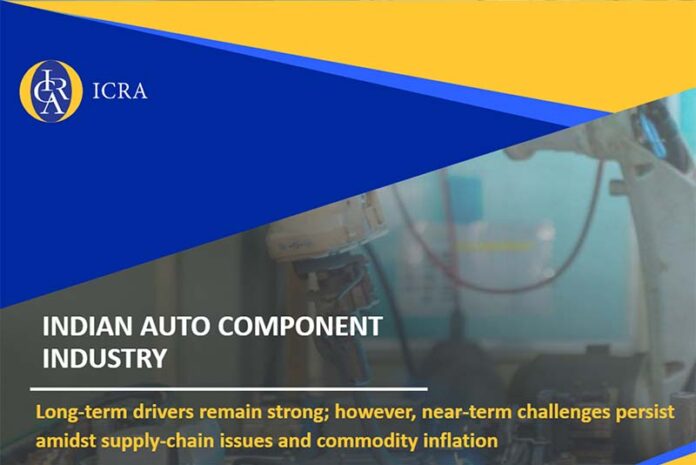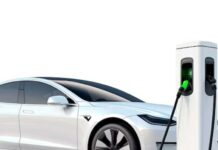
ICRA expects a 13-15% revenue growth in FY2022 for the Indian auto component industry, driven by domestic OEM, replacement, export volumes and pass-through of commodity prices. The healthy volume growth would, however, come on a low base of FY2021. For FY2023, revenues are likely to expand by 8-10% supported by easing of supply-chain issues and commodity inflation in H2 FY2023. Over the long term, premiumization of vehicles and focus on localisation will translate into healthy growth for auto component suppliers.
As per the recent report published by ICRA on Auto Components industry, Ms. Vinutaa S, Assistant Vice President & Sector Head – Corporate Ratings, ICRA Limited, says, “Demand for auto components stems from domestic OEMs, replacement and exports. Domestic OEM demand has remained a mixed bag across segments in FY2022, with slowdown in 2Ws and semiconductor shortage dragging down overall production volumes. Exports have remained a bright spot in the Indian auto component story, partly aided by the China+1 strategy. This is despite supply chain issues. ICRA believes that the growth in FY2022 exports would have been even better if not for the semiconductor shortage. While auto ancillaries have a healthy export order book for the next few months, the impact of geopolitical and supply-chain issues on actual offtake remains a monitorable.”
In the aftermarket/replacement market, improvement in personal mobility, healthy freight movement and deferment of new vehicle purchases due to cost inflation have supported replacement sales in the last few months. Part of the revenue growth has also come from commodity pass-through. While Jan to mid Feb was relatively dull because of the Omicron wave, demand has picked up in the last few weeks. Liquidity in aftermarkets is comfortable currently. There were some issues in collections in January 2022, because of Omicron-related absenteeism/quarantining and consequent inability to collect payments, but that has subsequently improved. Demand for public and private transport as schools and offices reopen, and improvement in economic activity and freight movement, is likely to aid replacement volumes in the next few months.
Cost inflation and semiconductor shortage remain headwinds for the industry. With the sharp increase in commodity prices in the last 3-4 quarters, auto ancillaries have not been able to pass through entirely, resulting in a decline in gross margins. Also, the ongoing Ukraine-Russia geopolitical tension could lead to supply shortages and increase commodity prices, especially steel and aluminium. Further, increase in crude prices will have a bearing on fuel costs for auto ancillaries. Freight rates have increased by 4-5x in the last one year, and likely to remain at elevated levels in the near term. Supply chain uncertainties, inflation and need for inventory stocking have led to incremental inventory requirements as well. Overall, operating margins for auto ancillaries are likely to be impacted in the near term. While the semiconductor situation has been improving in the last 1-2 months, the Russia-Ukraine conflict could stress the globalised chip value chain. The impact of geopolitical developments on semiconductor supplies remains a monitorable.
Coming to financial performance, if the Q1 FY2021 impact is excluded, the margins for Q2-Q4 FY2022 for ICRA’s auto components (ex-tyre) sample of 45 large auto ancillaries is likely to be lower by 200-250 bps on YoY basis in FY2022. While cost pressures are likely to continue in H1 FY2023, ICRA expects YoY improvement of 100 bps in operating margins in FY2023, because of a relatively better expectation for H2 FY2023. The operating margins for the ex-tyre sample is likely to return to pre-Covid levels of 10-10.5% in FY2023.
Adds Ms. Vinutaa,“Despite lower operating profits because of the commodity inflation, the overall interest cover continues to remain comfortable for most auto component suppliers with ICRA at 8.9. times in Q3 FY2022 vis-à-vis 8.0 times in FY2021 and 10.9 times for Q2-Q4 FY2021. Debt metrics remain strong across most auto ancillaries and it is likely to continue going forward as well, aided by healthy accruals and modest debt funding. Liquidity position also remains comfortable across Tier-I and tier-II players. Majority of ICRA rated auto ancillaries continue to be in investment grade, reflecting a healthy credit profile.”
Our interaction with large auto component suppliers indicates a cautiously optimistic approach towards capex/investment plans for FY2023. ICRA Research expects auto component suppliers to gradually increase their capex/investment outlay in FY2023, though most of these investments will be largely funded by internal accruals. The incremental investments will be primarily towards capability development i.e. new product additions and committed platforms, unlike the investments towards capacity expansion witnessed in the past. There is some capex happening for development of advanced technological and EV components as well. The recently-announced PLI scheme will also contribute to accelerating capex.









